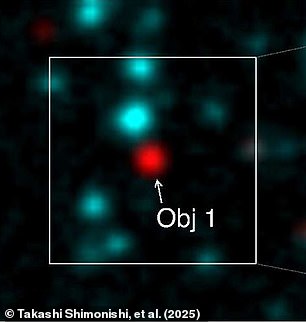A pair of ‘icy balls’ discovered in a distant stretch of the Milky Way have left scientists baffled.
The ‘peculiar’ objects don’t resemble anything scientists have seen before and could even be an entirely new kind of star.
Japanese researchers first spotted the balls in 2021, but it is only now that telescope observations have confirmed just how strange they are.
According to this new study, the light coming from these distant objects doesn’t fit with anything predicted by current theories about star formation.
Although they resemble dense clouds of gas or newly forming stars, they are totally isolated from regions where stars normally form.
Likewise, even though they give out infrared light as a star would, this doesn’t line up with the large amounts of ice that surround them.
To make things even stranger, the only two examples ever found are located extremely close to one another in the sky.
Lead researcher Dr Takashi Shimonishi, of Niigata University in Japan, says: ‘We tried our best to reproduce the properties, but currently we cannot find any theories that can explain the spectral energy properties.’

When Dr Shimonishi first spotted the two icy balls, it was immediately clear that they were exceptionally odd.
The objects were spotted using the Japanese AKARI space telescope, which scanned the Milky Way in the infrared spectrum between 2006 and 2011.
This revealed that although the objects were close together in the sky, they were actually far enough apart to be unrelated.
Dr Shimonishi and his colleagues estimated that Object 1 is about 9.3 kiloparsecs (30,332 light years) from the Sun in a region of the Milky Way called the Crux-Scutum Arm.
Object 2, meanwhile, is 13.4 kiloparsecs (43,704 light years) from the sun in the Carina-Sagittarius Arm.
Although Dr Shimonishi’s initial observations suggested that these objects were unusual, the space telescope didn’t have the resolution needed to reveal more.
Now, the researchers have used the Atacama Large Millimeter/submillimeter Array (ALMA) in Chile to look again in the hope of resolving this mystery.
And even with the help of the largest telescope in existence, these two icy orbs still don’t look anything like any other object in the universe.



If anything, this new set of measurements only raised more questions.
The ALMA observations show that the balls are somewhere between one and 10 times the size of our solar system.
Although that might seem vast, this makes the objects relatively small compared to other gas clouds.
Additionally, the wavelengths of light escaping the object suggest that they are composed of carbon monoxide and silicon dioxide.
The fact that there is a lot of silicon compared to the amount of carbon is what you would expect to find where a young star is violently blasting out new material.
However, Dr Shimonishi says that the objects’ small size, high ice content, and isolation don’t match any other type of star known to science.
For this reason, the researchers suggest that they may have found a previously unknown type of object.
Professor Jane Greaves, an astronomer from the University of Cardiff who was not involved in the study, told New Scientist: ‘It’s a fascinating piece of work, albeit rather puzzling.

‘The two objects seem to have contradictory characteristics, being cold enough to have abundant ice, but also infrared emission like a star.’
Dr Shimonishi and his co-authors have now applied to use the James Webb Space Telescope (JWST) to gather new data about these strange objects.
Those observations could help settle the question of whether these icy balls fit within our current theories of star formation or not.
Dr Shimonishi says: ‘JWST is very sensitive and has a high spectral resolution, so we can do a very detailed analysis of ice or dust, which can help us understand the thermal history of the source.’
